Synod members have voted to authorise a possible sale of the Archbishop's present residence, Bishopscourt.
The ordinance has passed all but the final stage, which will come on Monday.
Debate on a motion to authorise a 'sale window' of 5 years, took most of the night session on Day 2 of the Synod and resulted in a ballot, by houses, which overwhelmingly passed the measure.
Introduced by Diocesan Registrar Dr Philip Selden and seconded by the Rector of Toongabbie, Raj Gupta, Dr Selden said reports over the last 30 years had consistently recommended sale of the neo-gothic building.
Bishopscourt is listed on the Register of the National Estate and is one of the most significant properties in Sydney. Formerly Greenoaks, it was built in the 1850’s by wealthy businessman Thomas Sutcliffe Mort. It was bought by the church to replace the original “Bishopscourt” at Randwick and has been the official residence of the Archbishop of Sydney since 1911. In 1993, Archbishop Harry Goodhew called for the construction of a new residence and the matter was raised again in 2007 when Archbishop Peter Jensen asked the Diocesan CEO to again look into the feasibility of a sale.
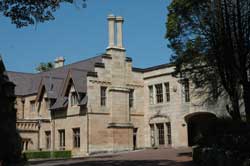
Dr Selden pointed to the report of the Archbishops strategic commission which called the building a 'lazy asset', saying it produced no income but cost at least 100 thousand dollars a year to keep in good repair, as well as other expenses. The registrar appealed to the Synod, saying 'Please do not choose sentiment for a property over people and ministry'. He said the continued expense made running the office of the Archbishop extremely difficult.
The movers of the motion wanted a five year window of authorisation, to allow for a sale at the best possible time for the market. They declined to put a figure on the value of the property saying to do so would influence the sale price.
Mr Gupta seconded the motion saying the last time the issue came before the Synod in 2010, he voted against it. He said there were compelling arguments, but at that time there were governance issues which led him to vote no. Now, Mr Gupta said, he was convinced there had been 'massive progress' in the area of governance. He said the oversight of the Property Trust and the fact that Standing Committee must approve any sale price and signoff on the deal was 'another mechanism for protection'.'
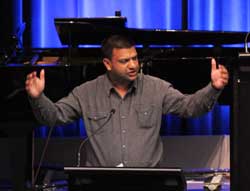
"I would not be sanctioning this ordinance if it was a fire sale" Mr Gupta said.
Several speaker rose to both support and oppose the sale.
The Rector of Naremburn / Cammeray, Rick Smith said he would vote no because "there are still too many things I am uncomfortable with...." Not ruling out a sale sometime in the future, Mr Smith said "I don't think a property like this was ever intended to be part of an investment portfolio and don't think the amount spent on upkeep is 'out of order'."
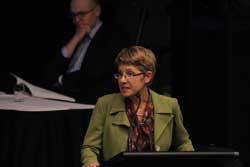
Dr Karin Sowada, a member of Standing Committee, quoted the late Boak Jobbins in saying Bishopscourt 'weaved its magic' around those who lived in it. "I love that property as much as most of us in this room but it has its limitations. There is never a good time to sell but the case for keeping it can no longer be sustained." Dr Sowada said.
Likewise, Alicia Watson, a lay representative of Darling Point parish, spoke of spending many happy hours at Bishopscourt as a teenager. Ms Watson said she opposed the sale in 2010 but "after prayerful consideration I have come to the conclusion that it now belongs to a bygone era." She spoke of the difficulties of the building which affected the running the household at Bishopscourt. "We must find something that is not an enormous millstone around the next, particularly of the wife, of the next Archbishop" Ms Watson said.
Peter Young, from Mosman parish, opposed the sale and called Bishopscourt 'irreplaceable' for ministry. He warned the net proceeds of any sale would be substantially reduced by professional costs.
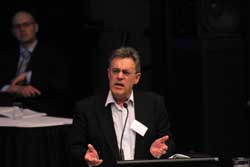
Dr Stuart Piggin,(pictured above) called for a no vote, saying in a city where Anglican churches are "some of the finest gothic revial churches in the world" Bishopscourt was 'emblematic'. He said it would be better to sell the St Andrew's House office block in the city than Bishopscourt. "We should sell Bishopscourt after the americans sell the White House. It has far more value to the diocese than to anyone who would ever buy it" Dr Piggin said.
Peter Kell, who chaired the Archbishop's commission which recommended a sale, spoke of the fact that the Archbishop only lives in a small self-contained flat within the building. "Notwithstanding the magnificence of the building and the enjoyment we get from visiting it, in that whole enormous structure the accommodation we provide for our Archbishop falls far short of rectory standard. We are not looking after our archbishop by leaving him there." Mr Kell also said if the motion failed, there would need to be other ways to pay for a shortfall in the balance sheet of the Endowment of the See "If you oppose this you are voting to substantially increase the money your parish would have to pay to fulfil the obligations for the diocese to be episcopally led."
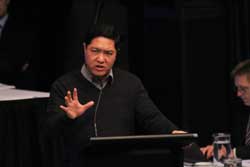
The Rector of Fairfield and Bossley Park, Peter Lin appealed for a yes vote, acknowledging the historical place of the residence but saying the building "is not lost to our history if we sell it." Pointing out that "two million dollars was spent on the chimneys" Mr Lin said some members of his congregation had been 'scarred' by their visits there because the opulence contrasted with the way Christians lived in other countries. "I won't be taking my people there again' Mr Lin said.
The ordinance will now go to the final reading stage, considered a formality, on Monday.
Under amendments to the bill,details of any sale will be reported to the Synod.
















